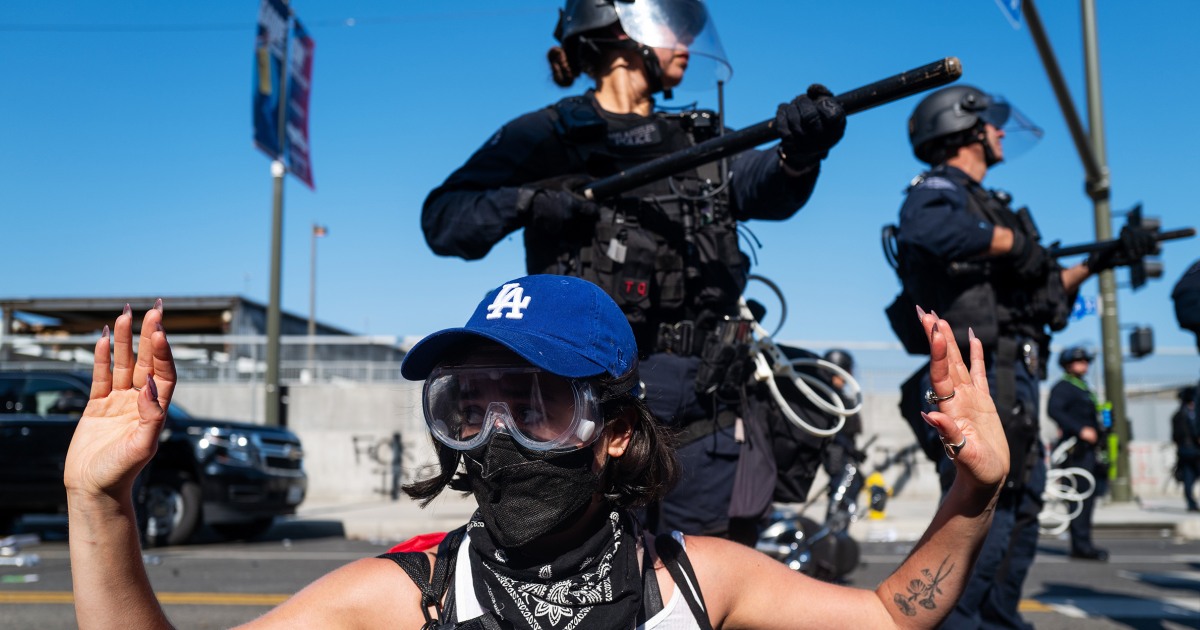The Incident: A Disturbing Encounter in Los Angeles
British photographer Nick Stern found himself at the center of a troubling scene in Los Angeles when he was struck by a 14mm high-velocity "sponge bullet" during a standoff between protesters and law enforcement. This traumatic event unfolded on a Saturday evening, casting a spotlight on the escalating tensions around immigration enforcement in the city.
The Setting: A City on Edge
Stern, 60, arrived at the Paramount area after hearing reports of federal agents conducting immigration enforcement operations. “I thought by the time I get down there it’ll be over…but as the day went on things seemed to escalate,” he shared with The Times of London. His concern was palpable, reflecting the heightened atmosphere that characterized that day.
A Chaotic Scene
Upon his arrival, Stern encountered a chaotic scene: a car was ablaze, and overhead, a Black Hawk helicopter hovered, reportedly dropping off ammunition for ICE officials—”boxes and boxes of it,” as Stern described. The presence of law enforcement was overwhelming, with officers armed not just with standard gear but also with “less-lethal weapons” such as flash-bangs and sponge rounds, the latter designed to inflict pain without the lethality of traditional ammunition.
The Moment of Impact
The pivotal moment came around 9 p.m. local time when Stern was documenting two young women waving a Mexican flag toward a line of sheriff’s deputies. In a shocking turn of events, he felt a “horrific shooting pain impacting my leg” before losing consciousness. “They’re supposed to shoot the ground in front of people, not target individuals,” he lamented, voicing his confusion and anger over why he became a target.
Immediate Aftermath
Following the impact, blood began to pour from Stern’s leg, and he was swiftly taken to a hospital where he underwent scans, X-rays, and ultimately surgery. This medical intervention highlighted not just his physical injuries but also the potential psychological effects of such violence in a confrontational atmosphere.
A Portrait of Fear
Reflecting on the broader implications of the events, Stern expressed his fears regarding the escalating situation in Los Angeles. He pointed to President Trump’s deployment of the National Guard, suggesting that this heightened military presence could lead to “indiscriminate targeting of everybody who’s at the protests.”
Looking Ahead: Concerns of Escalation
Stern’s apprehensions extend beyond the immediate chaos. “I feel it’s going to get worse before it gets better," he noted. His prediction came with a chilling thought: “I wouldn’t be surprised if they start firing live rounds over people’s heads next.” This statement resonates deeply, hinting at a disturbing paradigm shift in how protests are managed in urban environments.
The Role of Media
Despite the dangers he faced, Stern made a conscious effort to remain visible as media during the standoff. He wore a press ID around his neck and held a large video camera, embodying the role of a chronicler in times of unrest. However, his experience underscores the risks that journalists and photographers encounter when covering stories that are fraught with tension and violence.
Silence from Authorities
Notably, the Los Angeles Police Department (LAPD) did not respond to requests for comment regarding the incident. Their silence raises questions about accountability and the treatment of both citizens and media personnel during confrontations with law enforcement.
In sharing his harrowing experience, Nick Stern has not just become a victim of police violence; he has also highlighted the broader implications of escalating tensions in urban settings, urging awareness and consideration for those caught in the crossfire, whether they are protesters, journalists, or bystanders.


